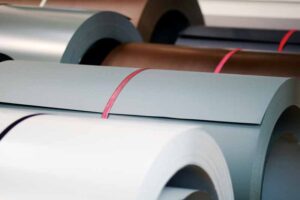Coiled Again
by Brooke Smith | 29 February 2024 8:48 am

As the world moves toward net zero by 2050, the building and construction sector must comply with stricter environmental regulations. Being a good global citizen is not only a moral duty, but also a business advantage. Companies need to adopt better practices and processes to reduce their own impact and choose their partners based on their circularity performance.
Metal building materials producers face many challenges as environmental, social, and governance (ESG) standards change. They need to manage and measure their ESG performance and provide emissions data to regulators, customers, and suppliers. They are also facing a potential reclassification of critical raw materials used in their products, such as fluoropolymers in coil coatings.
Companies may need to report their annual carbon footprint reductions from cradle-to-grave and cradle-to-gate. They may also have to provide emission data for all products sold to their customers.
These changes are increasing customers’ expectations of coil manufacturers to offer them more sustainable solutions and products. There is a growing demand for greener urban spaces without compromising performance.
Coil producers can help reduce emissions in the built environment by using modern cool chemistry coatings. These coatings use heat-reflective pigments to insulate buildings against hot or cold weather, lowering energy consumption and CO2 emissions.
Coil producers can also help by reducing their own energy consumption and emissions during the production process. The European Council of the Paint, Printing Ink, and Artist’s Colours Industry (CEPE) found 90 percent of emissions from coated steel cladding came from the production of steel substrate, which can be recovered and reused. The energy consumption of coatings was comparatively small, mostly from the curing process.
Coil coaters can reduce their Scope 1 emissions by increasing energy efficiency and reducing the amount of coating that is wasted. They can also switch to infrared and induction-type ovens to save energy.
In the medium term, one coil producer is developing products that can be cured at lower peak metal temperatures, which can save energy. In the future, electron beam radiation coatings are expected to reduce energy consumption by five to nine times compared to thermal ovens.
This coil producer is working to reduce energy consumption in all areas of coatings manufacturing, which reduces its own Scope 3 emissions and the Scope 1 emissions of the coal coater itself. It also provides the carbon and emissions data for its products to help its customers comply with regulations and achieve their sustainability goals.
Coil producers are here to help navigate the changing sustainability landscape. Using decades of coating expertise they work with businesses in the built environment, from coil coaters to architects, to create effective, innovative, and sustainable solutions. They can also advise organizations on how best to protect buildings and, at the same time, reduce their environmental impact. Together, the coatings and coil manufacturing industries can help architects, developers, and specifiers in their quest to a more sustainable built environment.
Amanda Paterline, commercial marketing manager–Americas, Coil & Extrusion Coatings, AkzoNobel, is a seasoned professional in the coatings industry.
Source URL: https://www.metalconstructionnews.com/articles/features/coiled-again/